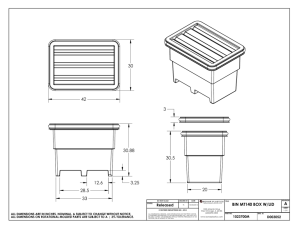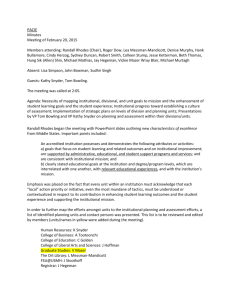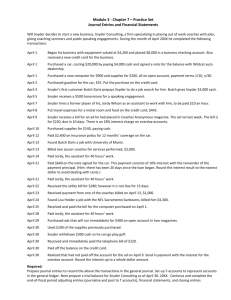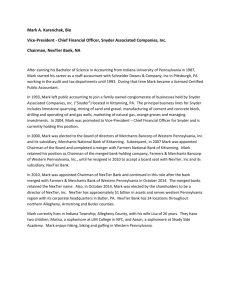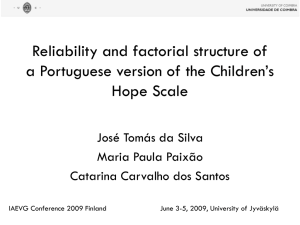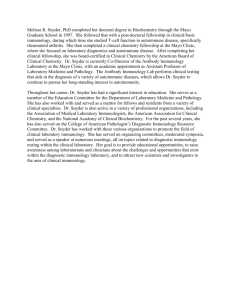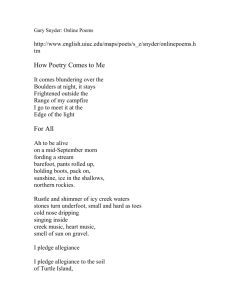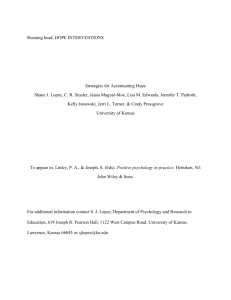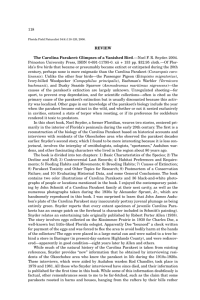Hope and the Academic Success of College Students
advertisement
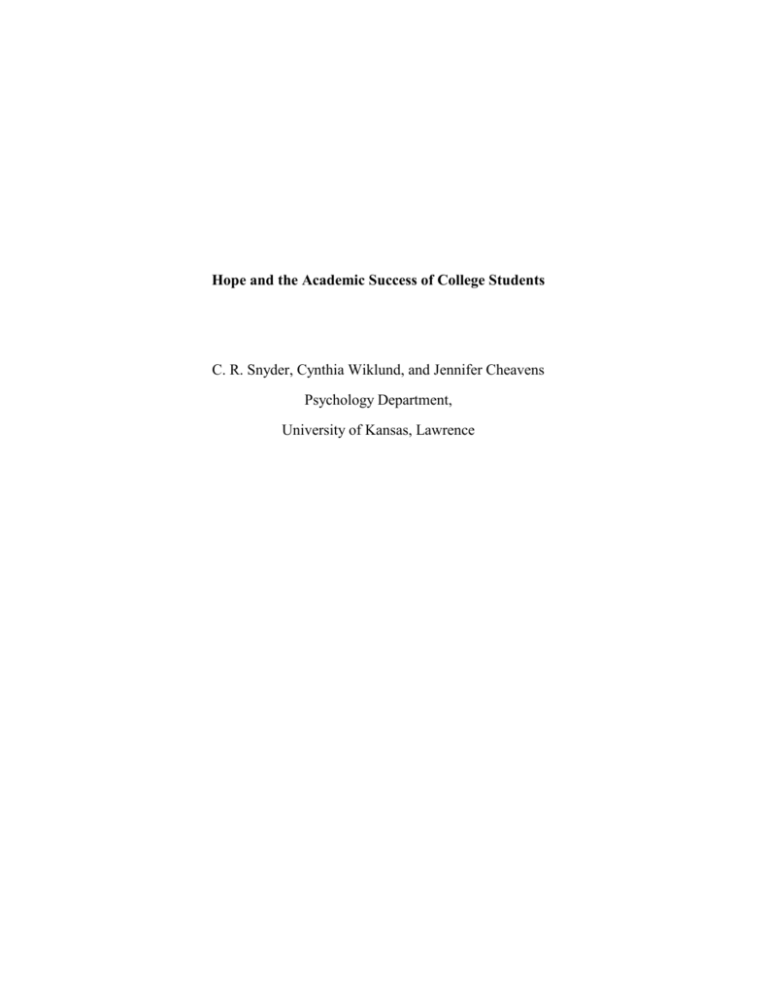
Hope and the Academic Success of College Students C. R. Snyder, Cynthia Wiklund, and Jennifer Cheavens Psychology Department, University of Kansas, Lawrence 500-1000 Word Abstract Hope and the Academic Success of College Students Snyder (1994) has developed a new theory of hope in which it is suggested that goaldirected thinking involves the perceived capability to (a) find routes to desired goals (the pathways component), and (b) energize oneself to utilize those routes (the agency component). Both the pathways and agency components are necessary to fully understand hopeful thinking. Furthermore, hopeful thinking is posited to apply to any goals that are of sufficient importance to demand considerable attention on the part of the person; moreover, such hopeful thinking operates when people perceive an intermediate probability of obtaining the goal (e.g., neither 0% or 100% perceived probability of goal attainment should elicit hope). Using this hope theory as a guide, a subsequent dispositional self-report index of hope known as the Hope Scale has been developed and validated (Snyder, Harris, et al., 1991). The Hope Scale has surpassed the normal psychometric standards regarding internal validity and test-retest reliability; moreover, the scale has demonstrated discriminant and concurrent validities. Furthermore, the Hope Scale has factored into the two posited agency and pathways components, which together contribute to an overall hope construct (Babyak, Snyder, & Yoshinobu, 1993). The Hope Scale also has been found to have considerable predictive power in regard to outcomes related to health, adjustment, and coping more generally, even when taking out the shared variances related to optimism, locus of control, positive and negative affectivity, self-esteem, and other psychological variables (Snyder, Sympson, Michael, & Cheavens, in press). In the academic arena, Hope Scale scores have correlated positively with college students' grades in several samples (Curry, Snyder, et al., 1997; Snyder, Harris, et al., 1991) (such correlations remain when the variances related to high-school grades are removed). Likewise, the Hope Scale has predicted significantly the final semester grades of college students (even when removing the shared variance related to performances on the first examinations of that semester) (Snyder, Harris, et al., 1991). Based on these positive goal pursuit outcomes in nonacademic and academic arenas, it was predicted that individual differences in trait hope as measured by scores on the Hope Scale should bear a positive relationship with subsequent academic-related performances over the years of college life. In this regard, the present six-year longitudinal study was undertaken to explore the predictive capabilities of hope for the criteria variables of cumulative grade point average, dropping out of school, and graduation. Method Male (N = 100) and female (N = 100) students participated in the experiment as a means of fulfilling the research requirements of their introductory psychology courses. Within one month of entering the University of Kansas, Lawrence, their participation in a longitudinal study was obtained, including permission to obtain their ACT entrance examination scores, as well as to track (through the Registrar's Office) their grades, dropping out, and graduating over the subsequent years. At this initial setting, the students were administered the 12-item (4 agency, 4 pathways, & 4 distracters) dispositional Hope Scale. Afterwards, they were thanked and dismissed. Results Findings revealed no differences in the female and male students on any measures. Dispositional hope, however, significantly predicted grade point average, and it did so beyond the variance related to ACT scores. Dividing the full range of Hope Scale scores into three separate groups, the grade point averages for each were as follows: low hope = 2.45; medium hope = 2.72; and, high hope = 2.85. In other words, there was almost one-half of a point difference between the low- and high-hope students in their average grades. Also, reliably more high-hope students had graduated than had their low-hope counterparts; moreover, significantly more low- than high-hope students were dismissed in poor standing. Furthermore, evidence suggests that those high-hope students who left did not do so because of difficulties with their academic work; rather, those few high-hope students who withdrew did so while in good academic standing. Discussion Previous research findings related to the benefits of children's and adults' hopeful thinking in various life arenas are reviewed (Snyder, Cheavens, & Michael, in press; Snyder, Hoza, et al., 1996), with a special emphasis on college academics. The implicit thinking processes of higher hope students about goal-pursuit activities are described, with the suggestion that the next step in research would be to teach incoming first-year college students to think in this hopeful manner. The crucial question would be whether such hope training, relative to no-training control comparison, would result in subsequent improvements in college performances. References Babyak, M., Snyder, C. R., & Yoshinobu, L. (1993). Psychometric properties of the Hope Scale: A confirmatory factor analysis. Journal of Research in Personality, 27, 154-169. Curry, L. A., Snyder, C. R., Cook, D. L., Ruby, B. C., & Rehm, M. (1997). The role of hope in student-athlete academic and sport achievement. Journal of Personality and Social Psychology, 73, 1257-1267. Snyder, C. R. (1994). The psychology of hope: You can get there from here. New York: Free Press. Snyder, C. R., Cheavens, J., & Michael, S. (In press). Hoping. In C. R. Snyder (Ed.), Coping: The psychology of what works. New York: Oxford University Press. Snyder, C. R., Harris, C., Anderson, J. R., Holleran, S. A., Irving, L. M., Sigmon, S. T., Yoshinobu, L., Gibb, J., Langelle, C., & Harney, P. (1991). The will and the ways: Development and validation of an individual differences measure of hope. Journal of Personality and Social Psychology, 60, 570-585. Snyder, C. R., Hoza, B., Pelham, W. E., Rapoff, M., Ware, L., Danovsky, M., Highberger, L., Rubinstein, H, & Stahl, K. (1997). The development and validation of the Children's Hope Scale. Journal of Pediatric Psychology, 22 (3), 399-421. Snyder, C. R., & Sympson, S., Michael, S., & Cheavens, J. (In press). The optimism and hope constructs: Variants on a positive expectancy theme. In E. C. Chang (Ed.), Optimism and pessimism. Washington, DC: American Psychological Association.
